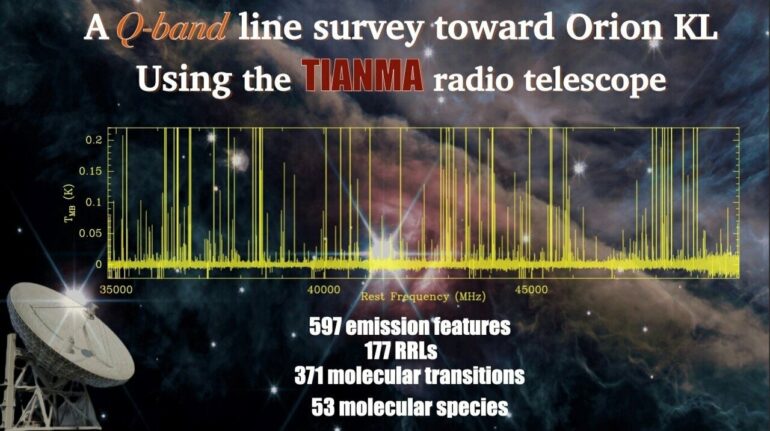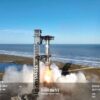A research team from the Shanghai Astronomical Observatory (SHAO) of the Chinese Academy of Sciences has recently completed a deep Q-band line scanning survey of the Orion Kleinmann–Low Nebula (Orion KL) using the Tianma 65-m radio telescope (TMRT), achieving the widest frequency coverage (35–50 GHz) and the highest sensitivity (~mK) spectra so far.
In total, about 600 emission lines were detected, including 177 radio recombination lines (RRL) and 371 molecular line transitions from 53 molecular species, among which 21 species were firmly detected for the first time in the Q band. This survey highlights the capability of TMRT to search for weak lines within extremely large wide-band spectra.
The study was published in The Astrophysical Journal Supplement Series.
Interstellar complex organic molecules play an important role in the origin of life. A wide-band line scanning survey of typical star-forming regions is one of the best methods to understand their physical and chemical properties, and to study the origin of complex organic molecules, especially prebiotic ones.
Orion KL is the closest high-mass star-forming region to Earth, at a distance of about 1,300 light-years. It is a molecular complex interacting with an expanding HII region (M42), and it consists of several gas components with various temperatures, including a cold environment gas component (500 K).
Those gas components have diverse chemical properties and contribute numerous emission lines in a wide range of wavelengths, many of which are the brightest in the sky. Thus, Orion KL is very suitable for a wide-band line scanning survey. However, previous line surveys of Orion KL were mostly conducted in short-millimeter, sub-millimeter or far-infrared bands. Line surveys in low-frequency bands such as the Q band (35–50 GHz) are very rare.
In fact, the Q band has irreplaceable advantages in searching for high-Δn RRLs, new molecular transitions and even new molecules.
TMRT is located in the western suburbs of Shanghai, China. It is at present the largest fully steerable radio telescope in Asia. Receivers from the L to Q band are available, covering a full frequency range of 1–50 GHz. The Q-band receiver developed by Dr. Zhong Weiye’s team from SHAO provides the highest frequency coverage at TMRT.
“TMRT is very suitable for wide-band line surveys. The TMRT Q-band line survey of Orion KL detected a tremendous amount of emission lines, and two-thirds of them have not been detected in previous line surveys,” said Liu Xunchuan, first author of the study.
When an electron is captured by an ion, it will continue to jump downward and generate a series of emission lines. Those emission lines are called RRLs if they appear in the radio regime. In the TMRT line survey, high-Δn RRLs such as H135π and C81γ were detected. These RRLs have the highest Δn detected in the Q band.
In addition, the survey detected (15, 15) and (16, 16) lines of NH3. It is the first time to detect NH3 emission lines with upper-state energies greater than 2000 K in a survey of Orion KL, indicating the existence of an extremely hot gas component in the Orion KL region.
Many complex organic molecules, such as NH2CHO, CH3OCHO, C2H5CN, CH3OCH3, CH3CH2OH and CH3COCH3, were also detected. These complex organic molecules are the foundation of more complex prebiotic molecules.
Furthermore, the researchers identified the emission lines of vibrationally excited states of ethyl cyanide (C2H5CN v13/v21) in the Q band. This is the first time to detect and identify Q-band emission of C2H5CN v13/v21 from the interstellar medium.
The detected complex organic molecules can be assigned to different gas components of Orion KL by comparing their line widths and central velocities. Aldehyde-containing species and species with both sulfur and oxygen elements tend to have spectral components originating from the plateau, which supports a possible abundance enhancement of these species by shocks.
“This survey reaches an unprecedented line sensitivity that demonstrates the huge potential of TMRT in astrochemistry studies,” said Liu Tie, a researcher at SHAO and co-corresponding author of the study.
“This Q-band deep line survey provides excellent guidance for similar line scanning surveys in the Q band of other targets,” added Prof. Qin Shengli from Yunnan University and co-author of the study.
In the future, the research team will conduct a deeper line survey of Orion KL, aiming to achieve a sensitivity of better than mK and extending the frequency coverage to the full Q/Ka band (26–50 GHz). Furthermore, the research team also plans to conduct line surveys in the Q/Ka band of a much larger sample of complex organic molecule-rich sources using TMRT.
“The follow-up surveys will build an unprecedented gallery of Q/Ka-band spectra of typical complex organic molecule-rich sources, and help to identify new complex organic molecules, especially the prebiotic species,” said Shen Zhiqiang, director of SHAO and a co-corresponding author of the study.
More information:
A Q-band Line Survey toward Orion KL Using the Tianma Radio Telescope, The Astrophysical Journal Supplement Series (2022). DOI: 10.3847/1538-4365/ac9127
Provided by
Chinese Academy of Sciences
Citation:
Tianma 65-m radio telescope helps to unveil mysteries of Orion Kleinmann–Low Nebula (2022, November 10)



